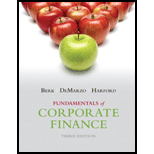
Capital markets:
Capital markets can be defined as the markets for buying and selling equity and debt instruments. These markets are important for the functioning of an economy, since capital is a significant component to generate the economic output.
Segmentation of financial or capital markets:
The major reasons for segmentation of capital markets are differential access to markets and macro-level distortions. In differential access to markets, a nation’s risk-free securities are internationally integrated but markets for a specific firm’s securities are not. Firms may face differential access to markets if there is any kind of asymmetry with respect to information about them. In macro-level distortions markets for risk-free instruments can also be segmented. The most significant
To determine:
The main implication for international
Want to see the full answer?
Check out a sample textbook solution
Chapter 23 Solutions
Fundamentals of Corporate Finance (3rd Edition) (Pearson Series in Finance)
- When the price of a bond is above the face value, the bond is said to be* Trading at par Trading at a premium Trading at a discount Trading below pararrow_forward7. What is a par value of a bond?* The amount borrowed by the issuer of the bond and returned to the investors when the bond matures The overall return earned by the bond investor when the bond matures The difference between the amount borrowed by the issuer of bond and the amount returned to investors at maturity The size of the coupon investors receive on an annual basisarrow_forwardWhat is an annuity?* An investment that has no definite end and a stream of cash payments that continues forever A stream of cash flows that start one year from today and continue while growing by a constant growth rate A series of equal payments at equal time periods and guaranteed for a fixed number of years A series of unequal payments at equal time periods which are guaranteed for a fixed number of yearsarrow_forward
- If you were able to earn interest at 3% and you started with $100, how much would you have after 3 years?* $91.51 $109.27 $291.26 $103.00arrow_forwardNo AI 2. The formula for calculating future value (FV) is* FV = PV/(1+r)^n FV = PV/(1+r)*n FV = PV x (1+r)^n FV = PV x (1+r)*narrow_forwardDividend??? solnarrow_forward
 Essentials Of InvestmentsFinanceISBN:9781260013924Author:Bodie, Zvi, Kane, Alex, MARCUS, Alan J.Publisher:Mcgraw-hill Education,
Essentials Of InvestmentsFinanceISBN:9781260013924Author:Bodie, Zvi, Kane, Alex, MARCUS, Alan J.Publisher:Mcgraw-hill Education,

 Foundations Of FinanceFinanceISBN:9780134897264Author:KEOWN, Arthur J., Martin, John D., PETTY, J. WilliamPublisher:Pearson,
Foundations Of FinanceFinanceISBN:9780134897264Author:KEOWN, Arthur J., Martin, John D., PETTY, J. WilliamPublisher:Pearson, Fundamentals of Financial Management (MindTap Cou...FinanceISBN:9781337395250Author:Eugene F. Brigham, Joel F. HoustonPublisher:Cengage Learning
Fundamentals of Financial Management (MindTap Cou...FinanceISBN:9781337395250Author:Eugene F. Brigham, Joel F. HoustonPublisher:Cengage Learning Corporate Finance (The Mcgraw-hill/Irwin Series i...FinanceISBN:9780077861759Author:Stephen A. Ross Franco Modigliani Professor of Financial Economics Professor, Randolph W Westerfield Robert R. Dockson Deans Chair in Bus. Admin., Jeffrey Jaffe, Bradford D Jordan ProfessorPublisher:McGraw-Hill Education
Corporate Finance (The Mcgraw-hill/Irwin Series i...FinanceISBN:9780077861759Author:Stephen A. Ross Franco Modigliani Professor of Financial Economics Professor, Randolph W Westerfield Robert R. Dockson Deans Chair in Bus. Admin., Jeffrey Jaffe, Bradford D Jordan ProfessorPublisher:McGraw-Hill Education





